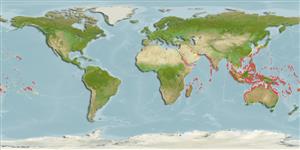Issue
Dascyllus abudafur<> former synonym of this species is resurrected with Indian Ocean distribution and D. aruanus restricted to Pacific Ocean. Information herein will be re-assigned accordingly.
Environment: milieu / climate zone / depth range / distribution range
Ecologia
marinhas associadas(os) a recifes; não migratória; intervalo de profundidade 0 - 20 m (Ref. 9710). Tropical; 38°N - 35°S, 19°E - 124°W
Pacific Ocean: region north and east of Lombok Strait to Line, Marquesan and Tuamoto islands, north to southern Japan, south to New Caledonia.
Length at first maturity / Tamanho / Peso / Idade
Maturity: Lm 5.0 range ? - ? cm
Max length : 10.0 cm TL macho/indeterminado; (Ref. 4391); common length : 6.0 cm TL macho/indeterminado; (Ref. 5450); Idade máx. registada: 6 anos (Ref. 72479)
Espinhos dorsais (total): 12; Raios dorsais moles (total): 11-13; Espinhos anais 2; Raios anais moles: 11 - 13. Color in life white with 3 black bars; a large brown spot on dorsal part of snout and interorbital; lips dusky or white; caudal fin pale; pelvic fins black; pectorals transparent. Margins of preorbital, suborbital, and preoperculum finely serrated (Ref. 2746). Body depth 1.5-1.7 in SL (Ref. 90102).
Territorial, inhabit shallow lagoon and subtidal reef flats. Form large aggregations above staghorn Acropora thickets or in smaller groups above isolated coral heads. Feed on zooplankton, benthic invertebrates, and algae. Males invite females to spawn in their nests; protecting the eggs until they hatch and becoming very aggressive against other fish. Eggs hatch after 3-5 days; pelagic larvae feed on plankton (Ref. 5503). Oviparous, distinct pairing during breeding (Ref. 205). Used in behavioral study. Have been reared in captivity (Ref. 35412). Diurnal species (Ref. 54980, 120737).
Male selects and protects the nest; does the courtship `dance' about 1 m above the nest and escorts the attracted female to the nest site where spawning ensues (Ref. 33146). Oviparous, distinct pairing during breeding (Ref. 205). Eggs are demersal and adhere to the substrate (Ref. 205). Also Ref. 103751.
Borsa, P., A. Sembiring, C. Fauvelot and W.-J. Chen, 2014. Resurrection of Indian Ocean humbug damselfish, Dascyllus abudafur (Forsskål) from synonymy with its Pacific Ocean sibling, Dascyllus aruanus (L.). Comptes Rendus Biologies, Elsevier Masson, 337(709-716). (Ref. 119133)
Categoria na Lista Vermelha da IUCN (Ref. 130435)
Ameaça para o homem
Harmless
Utilização humana
Pescarias: sem interesse; Aquário: Espécies comerciais
Ferramentas
Relatórios especiais
Descarregue XML
Fontes da internet
Estimates based on models
Preferred temperature (Ref.
123201): 24.9 - 29.3, mean 28.4 °C (based on 2883 cells).
Phylogenetic diversity index (Ref.
82804): PD
50 = 0.5005 [Uniqueness, from 0.5 = low to 2.0 = high].
Bayesian length-weight: a=0.02239 (0.01732 - 0.02894), b=2.95 (2.88 - 3.02), in cm total length, based on LWR estimates for this species (Ref.
93245).
Nível Trófico (Ref.
69278): 3.3 ±0.42 se; based on food items.
Resiliência (Ref.
120179): Médio, tempo mínimo de duplicação da população 1,4 - 4,4 anos (tmax=6; Fec=1,500-2,000).
Fishing Vulnerability (Ref.
59153): Low vulnerability (10 of 100).
Nutrients (Ref.
124155): Calcium = 110 [52, 178] mg/100g; Iron = 0.796 [0.461, 1.348] mg/100g; Protein = 18.2 [17.0, 19.3] %; Omega3 = 0.117 [0.065, 0.201] g/100g; Selenium = 19.4 [9.7, 40.5] μg/100g; VitaminA = 185 [52, 631] μg/100g; Zinc = 1.52 [0.99, 2.25] mg/100g (wet weight);
